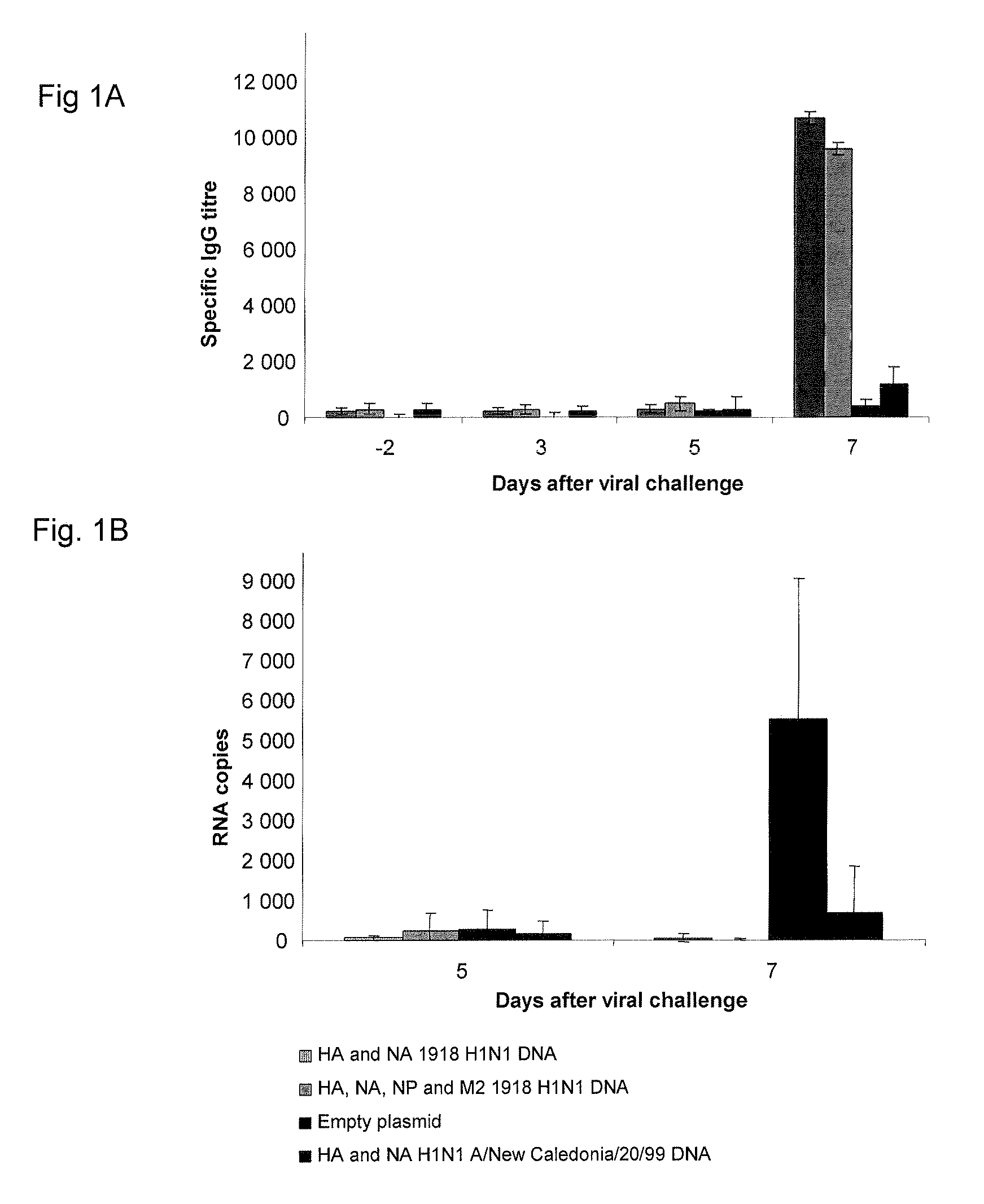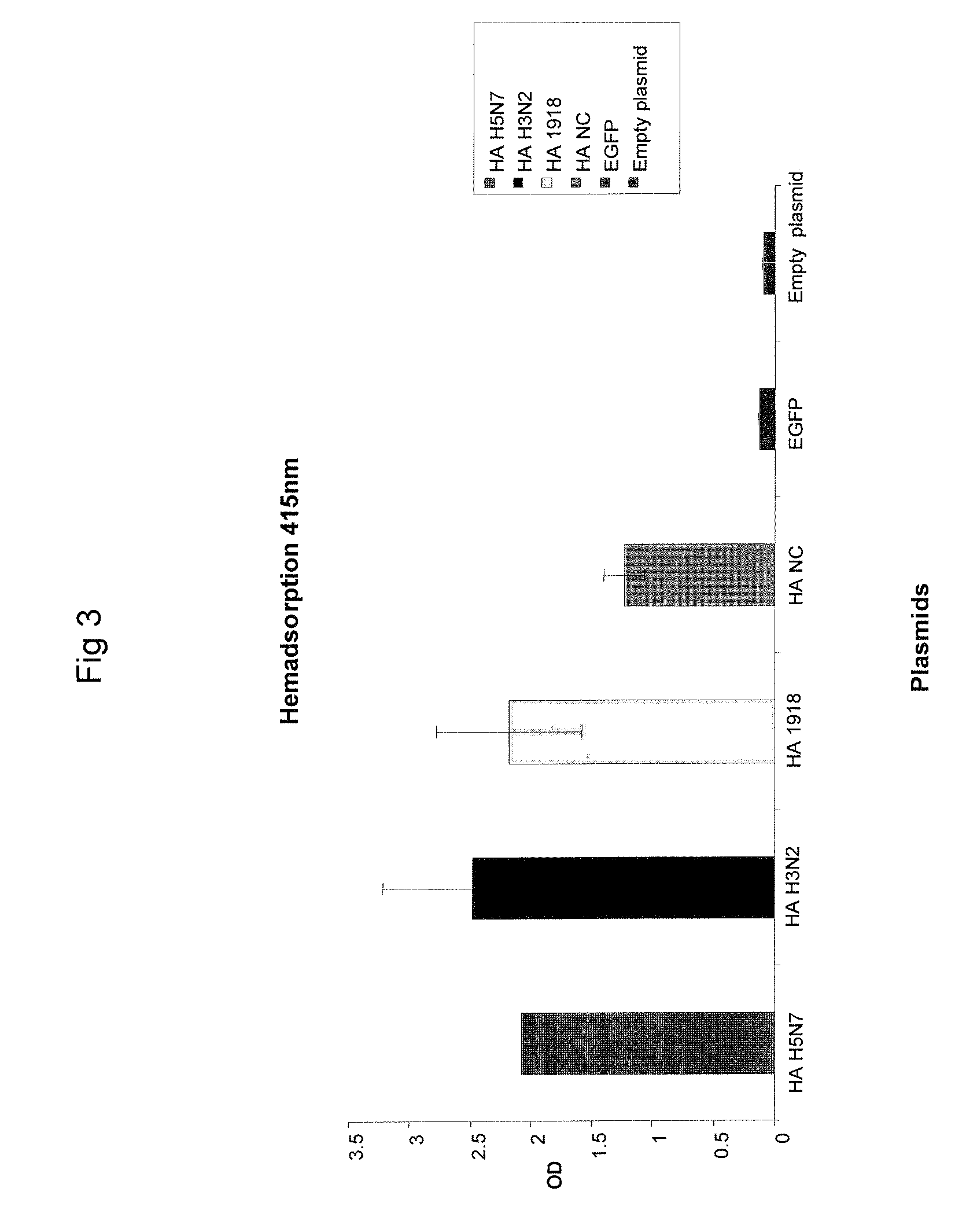Influenza vaccines
a technology for swine and human influenza, applied in the field of human and swine influenza vaccines, can solve the problems of large burden on health care costs and productivity loss, swine are susceptible to human and avian influenza virus, and serve as dangerous mixing vessels, etc., to achieve broad and efficient protective immunity, low cost, and high level of cross protection
- Summary
- Abstract
- Description
- Claims
- Application Information
AI Technical Summary
Benefits of technology
Problems solved by technology
Method used
Image
Examples
example 1
Construction of Expression Vectors
[0079]The 1918 pandemic H1N1 genes were designed from nucleotide sequences published in GenBank (HA: A / South Carolina / 1 / 18 AF117241, and NA, NP and M: A / Brevig Mission / 1 / 18 AF250356, AY744035 and AY130766, respectively). The genes were made synthetically and designed to include the appropriate restriction enzymes and Kozak sequence (GCCACC), −1 base upstream from the start codon, for efficient cloning and transcription in the WRG7079 expression vector (PowderJect, Madison, Wis.). The genes were synthesised using only codons from highly expressed human genes (5) (codon optimised). By this the nucleotide codons are altered (humanised), but the encoded amino acids are identical to those encoded by the viral RNA. The genes were further cloned individually into the WRG7079 expression vector. Key elements in the expression vector are a kanamycin resistance gene, cytomegalovirus immediate-early promoter, intron A, and polyadenylation signal. The tissue pla...
example 2
Immunisations
[0082]A total of 24 ferrets (Mustela Putorius Furo), approximately seven months old, were divided in four groups by using a chip-tag identification for dogs (E-vet, pet-id, Haderslev, Denmark), six animals in each group. All animals were kept together and fed a standard diet with food and water ad libitum. The animals were housed according to the Danish Animal Experimentation Act and kept at level II biosecurity facilities at the Faculty of Life Sciences, Copenhagen. The acclimatisation period was nine days.
[0083]Four groups of six ferrets were vaccinated as follows; (1) HA (codon optimised gene) and NA (codon optimised gene) 1918 H1N1 plasmid DNA vaccinated, (2) HA, NA, NP and M (all codon optimised) 1918 H1N1 plasmid DNA vaccinated, (3) empty plasmid vaccinated (negative vaccine control) and (4) HA and NA (not codon optimised) A / New Caledonia / 20 / 99(H1N1) plasmid DNA vaccinated (positive vaccine control). All ferrets received four standard gene gun shots onto shaved ab...
example 3
Quantitative Real Time RT-PCR Assay for Influenza A
[0084]At the day of blood serum collection the nostrils of each ferret were flushed with 1 ml PBS and the flushing were frozen down immediately for real-time RT-PCR analysis. Two hundred micro litres of nasal wash were extracted on an automated MagNA Pure LC Instrument applying the MagNa Pure LC Total Nucleic Acid Isolation Kit (Roche diagnostics, Basel, Switzerland). The extracted material was eluated in 200 μl Milli-Q H2O. The RT-PCR reactions were performed with oligonucleotide sequences as described by Spackman et al., (23). Extracted material (5 μl) was added to 20 μl of master mix consisting of 10 nM of each primer and 2 nM of the Taqman probe labelled with FAM in the 5′ end and black hole quencher 1 in the 3′ end together with reagents from the OneStep® RT-PCR Kit (QIAGEN, Hilden, Germany) according to the manufacturer. Target sequences were amplified on the MX3005 system from Stratagene with the following program: 20 min 50°...
PUM
| Property | Measurement | Unit |
|---|---|---|
| diameter | aaaaa | aaaaa |
| time | aaaaa | aaaaa |
| temperature | aaaaa | aaaaa |
Abstract
Description
Claims
Application Information
 Login to View More
Login to View More - R&D
- Intellectual Property
- Life Sciences
- Materials
- Tech Scout
- Unparalleled Data Quality
- Higher Quality Content
- 60% Fewer Hallucinations
Browse by: Latest US Patents, China's latest patents, Technical Efficacy Thesaurus, Application Domain, Technology Topic, Popular Technical Reports.
© 2025 PatSnap. All rights reserved.Legal|Privacy policy|Modern Slavery Act Transparency Statement|Sitemap|About US| Contact US: help@patsnap.com



